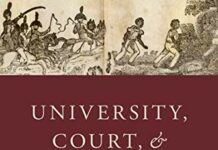
Ebook Info
- Published: 2002
- Number of pages: 208 pages
- Format: PDF
- File Size: 1.89 MB
- Authors: Alfred L. Brophy
Description
The 1921 Tulsa Race Riot was the country’s bloodiest civil disturbance of the century. Leaving perhaps 150 dead, 30 city blocks burned to the ground, and more than a thousand families homeless, the riot represented an unprecedented breakdown of the rule of law. It reduced the prosperous blackcommunity of Greenwood, Oklahoma, to rubble. In Reconstructing the Dreamland, Alfred Brophy draws on his own extensive research into contemporary accounts and court documents to chronicle this devastating riot, showing how and why the rule of law quickly eroded. Brophy offers a gut-wrenching portrait of mob violence and racism run amok,both on the night of the riot and the morning after, when a coordinated sunrise attack, accompanied by airplanes, stormed through Greenwood, torching and looting the community. Equally important, he shows how the city government and police not only permitted the looting, shootings, and burning ofGreenwood, but actively participated in it. The police department, fearing that Greenwood was erupting into a “negro uprising” (which Brophy shows was not the case), deputized white citizens haphazardly, gave out guns and badges with little background check, or sent men to hardware stores to armthemselves. Likewise, the Tulsa-based units of the National Guard acted unconstitutionally, arresting every black resident they could find, leaving Greenwood property vulnerable to the white mob, special deputies, and police that followed behind and burned it. Brophy’s revelations and stark narrative of the events of 1921 bring to life an incidence of racial violence that until recently lay mostly forgotten. Reconstructing the Dreamland concludes with a discussion of reparations for victims of the riot. That case has implications for otherreparations movements, including reparations for slavery.
User’s Reviews
Editorial Reviews: Amazon.com Review In the spring of 1921, black Oklahomans seeking economic and political equality collided with a white society bent on keeping them down. The result was a devastating attack on the African American quarter of Tulsa called Greenwood, in which hundreds of buildings were destroyed and unknown numbers of people were killed. Legal scholar Alfred Brophy pieces together some of the puzzles surrounding this event, which many Oklahoma officials did their best to hide from history. Indeed, as he remarks, “Tulsa has denied the tragedy for so long that it is easy to forget it ever happened.” Brophy examines the role of the police and National Guard in assisting the white attackers, that of the courts in exonerating them and instead attaching blame to the victims, and that of the media in whipping up ethnic hostility. He also asks what can be done, so many years after the fact, to redress past wrongs and “the complete breakdown of the rule of law,” and he concludes that reparations are in order. Students of modern American history and of civil rights law will find much to ponder in Brophy’s measured account of this shameful episode. –Gregory McNamee From Library Journal One of America’s bloodiest civil disturbances is also one of its least known. On May 31,1921, Tulsa’s African American community of Greenwood was the site of a violent riot that left more than 30 city blocks burned, thousands homeless, and up to 300 dead. Fearing that a young man was going to be lynched for assaulting a young white woman, members of Tulsa’s African American community rallied at the courthouse. Seeing the large body of African Americans, some of whom had guns, in their part of town, whites armed themselves with all the weapons they could muster. A hail of fire erupted, and by the next day the National Guard and a mob of hastily deputized white citizens stormed the African American neighborhood of Greenwood, laying it to waste and incarcerating its residents in camps. These two works each seek to clarify what happened, but they take quite different approaches. Law professor Brophy served on the Tulsa Race Riot Commission, which was charged with determining exactly what happened and whether survivors should receive restitution. His book reflects his work on the commission, focusing on the legal issues surrounding the incident. He asserts that the riot was government-assisted and as such that the victims and their heirs are due compensation. This work fits very well into the growing national debate on reparations. Hirsch, the author of the best-selling Hurricane, seeks a broader audience in his book, which emphasizes events following the riot, including the thwarted attempts to rebuild Greenwood and how Tulsa and Oklahoma sought to come to terms with the riot. Although different in tone and approach, both books are very solid in their research and writing. Each is highly recommended, although Brophy’s account will appeal to the more serious reader. Daniel Liestman, Florida Gulf Coast Univ., Ft. Myers Copyright 2002 Reed Business Information, Inc. Review “Recovers a largely forgotten history of black activism in one of the grimmest periods of race relations, emphasizing the black militancy of the World War I era and how assertive black demands for racial equality threatened white Tulsans. Linking history with advocacy, Brophy also offers a reasoneddefense of reparations for the riot’s victims.”–Washington Post Book World”Meticulously researched…., A good job of showing how the true history of the riot was whitewashed, and how difficult it has been for white Tulsa–and white America for that matter–to acknowledge its racist past.”–San Diego Union Tribune”Brophy’s history of reparations is fascinating.”–St. Louis Post Dispatch”At once meticulously factual and riveting, Alfred Brophy’s moving account of a 1921 race riot that destroyed an economically self-reliant, vibrant African-American community clarifies why political action and enforcement of legal and human rights are indispensable perquisites for black economicopportunity and material progress. Brophy also clarifies why Americans need to find the courage to acknowledge injustices of the recent past and contrive amends to help heal still-unresolved consequences scarring both victims and perpetrators.”–Jane Jacobs”In his timely, well documented and powerfully written book, Reconstructing the Dreamland, Professor Al Brophy vividly illustrates a chapter of America’s sordid racist past by focusing on the Tulsa Race Riots of 1921. If we are to transcend the barriers to racial progress, we all must read Brophy’scompelling work and use it as a seminal case in our path to avoid conflicts at all costs. Simply put, Professor Brophy’s book is the best-written account of the Tulsa riots, and captures the people of Tulsa’s resolve to never allow a similar travesty to occur again. Every person interested inracial justice should have this book at his or her disposal.” –Charles J. Ogletree, Jr. Jesse Climenko Professor of Law, Harvard Law School About the Author Alfred L. Brophy is Professor of Law at the University of Alabama, in Tuscaloosa. An authority on the 1921 riot, he contributed to the report to the Tulsa Race Riot Commission, a body created by the Oklahoma Legislature to investigate the riot and make recommendations for reparations. Read more
Reviews from Amazon users which were colected at the time this book was published on the website:
⭐Read this book. This, like the book The Wilmington Lie, is the result of Confederate states’ anger over losing the Civil War. These crimes against citizens were the result of the destruction of Reconstruction, prompting and promoting the advent of “Redemption”, the restoration of white authority in America. George Wallace was the ugly face of racism in mid 20th century America, and he was the product of Redemption. Read this book. It is as much American history as is anything taught in all the history classes n every grade in school.
⭐We need to know
⭐Well written shocking account of an American travesty. The pictures and details lay bare the events of an unknown race riot on US soil. Readers should expect shock, disgust, wonder, amazement, sadness, and regret.
⭐Excellent story, well written. A story very few know but everyone should. Must read.
⭐It’s amazing what is covered up and can be lost to history. This book meticulously documents a revolting event that cries out for justice. Hard to make a stronger case for reparations than the Tulsa riots, yet white Okies refuse to deal with it.
⭐My specific interest in Mr. Brophy’s work is J. B. Stradford. The richest man in Greenwood at the time of the Tulsa massacre in June, 1921 was John the Baptist Stradford. The illuminating text about this seldom recognized man made my This Land Press article (to be published in May, 2014) about him rich with human reality, providing the sociological setting and a palpable sense of the unspeakable loss resulting from the Tulsa Race Rio of 1921.
⭐If you are a student of U.S. and/or African-American history you must read this book. The author A. Brophy walks us through the history and tragic events that caused the most horrific riot in the early history of the United States. This book is a powerful review of what can happen even in the 21st century. Mel C.
⭐I must confess that I knew nothing about this sad episode in American history. A fine book. Definitely worth reading, especially in light of recent events. Very thought-provoking.
⭐Another account of the Tulsa 1921 riot – the time leading up to the riot, the event itself, and the aftermath.Professor Brophy does look, in depth, at what has been done to put right, what happened on that fateful night.Have lessons been learned, and what compensation (if any) has been handed out, to those families who were affected.I’ve walked through Greenwood Avenue recently, without knowing what actually happened, and not appreciating the death & destruction that took place there.I wish I’d know before I got there, so I could have read up & been better prepared.Seeing the street markers, showing where properties once stood, and have gone – I now understand their significance, and can better appreciate, how bad that night must have been.It won’t be long before the 100th anniversary (2021) – I know that there are people out there, who are not going to let this sorry episode, be forgotten about, or swept under the carpet.
Keywords
Free Download Reconstructing the Dreamland: The Tulsa Race Riot of 1921, Race Reparations, and Reconciliation in PDF format
Reconstructing the Dreamland: The Tulsa Race Riot of 1921, Race Reparations, and Reconciliation PDF Free Download
Download Reconstructing the Dreamland: The Tulsa Race Riot of 1921, Race Reparations, and Reconciliation 2002 PDF Free
Reconstructing the Dreamland: The Tulsa Race Riot of 1921, Race Reparations, and Reconciliation 2002 PDF Free Download
Download Reconstructing the Dreamland: The Tulsa Race Riot of 1921, Race Reparations, and Reconciliation PDF
Free Download Ebook Reconstructing the Dreamland: The Tulsa Race Riot of 1921, Race Reparations, and Reconciliation

